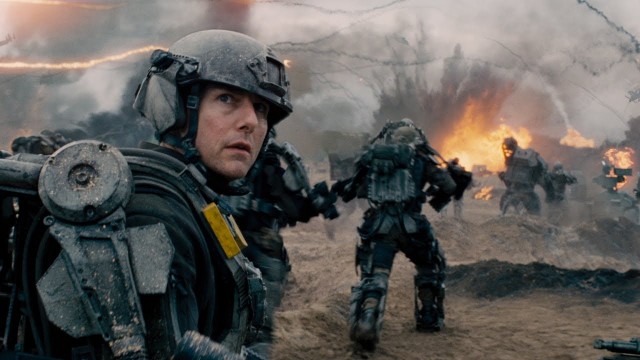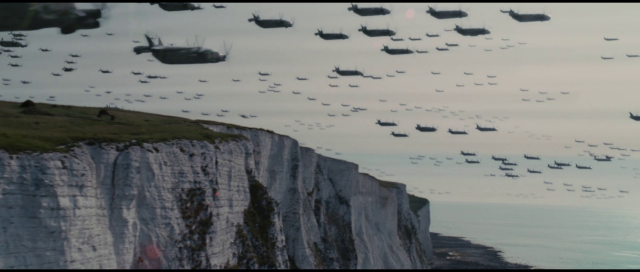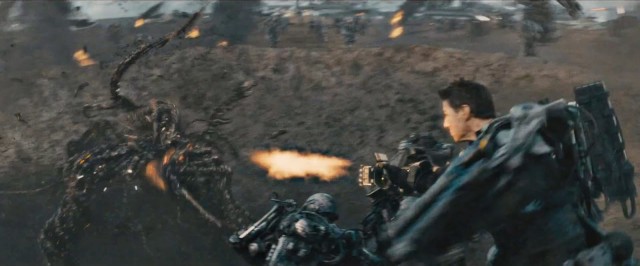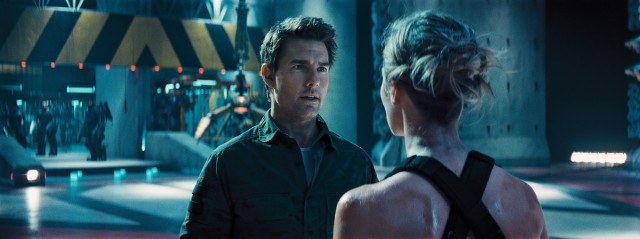There’s a particular recipe for a Tom Cruise action blockbuster, one that has long persisted since the likes of Top Gun. Lots of high speed, over-the-top cinematography, and the unwritten rule that Cruise is essentially bulletproof are the chief ingredients. Only in passing exceptions such as War of the Worlds has Cruise deviated from this template.
Fortunately, we have another attempted deviation in Edge of Tomorrow, loosely inspired by the Japanese novel and manga, All You Need is Kill, by Hiroshi Sakurazaka. Playing against type, Cruise begins the movie as a coward who can’t stand the sight of blood or combat, and will actively do anything to get out of fighting and dying in an alien invasion. A further twist and a key marketing hook comes from Cruise’s character getting caught in a time loop that causes the day to reset every time he dies.
The juxtaposition of having Cruise, as one of the most famously ‘unkillable’ action stars, dying over and over again is yet another cheeky and sometimes downright funny way for the star to play with his image, and it lends to the majority of Edge of Tomorrow feeling fresh, original and very enjoyable. It’s just a shame then that it eventually runs out of steam and degrades into yet another familiar Cruise flick, ultimately petering out with a trite, laboured conclusion.
For the most part however, Edge of Tomorrow stands as one of this Summer’s more underrated blockbusters. It’s flashy, entertaining and generally memorable, so if you have a taste for popcorn sci-fi, or happen to be a Tom Cruise fan open to something somewhat different, it’s worth the trip.
Cruise stars as Major William Cage, a loose reference to the source text’s Japanese protagonist, Keiji Kiriya, who is dubbed ‘Killer Cage’ by American soldiers in the closing moments of the book. After losing his advertising firm to Earth being invaded by the alien Mimics, fast-moving and highly lethal creatures that appear as a mass of tumbleweed-like tendrils, Cage is summoned to ‘sell’ the war first-hand by joining a squad of soldiers running a D-Day-style invasion against the Mimics.
Problem is, Cage is a military figure in name only. He abhors battle and tries to do and say anything to get out of combat, which culminates in blackmailing the general enlisting him for the front lines. This leads to Cage’s arrest and labeling as a deserter, thus kicking off the movie’s events, namely its Groundhog Day-esque loop in time that begins after Cage is unceremoniously killed moments into battle, and ends up doused in Alpha Mimic blood that gives him the ability to reset the day by about thirty hours with every subsequent death he suffers, seemingly consistent with the source text.
Naturally, there’s some danger of repetition setting in with this device, even with the innate appeal of watching Cruise play someone who is the polar opposite of, say, Ethan Hunt. Fortunately, the movie knows when to place ellipses within the day that Cage is continually re-living. Over time however, the script effectively displays Cage’s gradual, and noticeable evolution from a coward, to a competent fighter, then a soldier, and finally, a leader.
In fact, there’s a bit of interesting mystery in certain scenes, where audiences will be kept guessing as to whether Cage may or may not have already experienced a new moment in a particular day. This helps to keep suspense pleasantly consistent, and prevents Edge of Tomorrow from degrading into a dumb, repetitive and disposable action flick.
In all fairness though, that’s what it starts becoming as it comes apart by its climax, and this is most evident with Emily Blunt’s female lead, Sergeant Rita Vrataski, maintaining her name from the source book, though now being British instead of American, naturally. Nicknamed the ‘Full Metal Bitch’ for her outstanding combat capability, Rita is much more the hero of Edge of Tomorrow, whipping Cage into shape over the course of his looping, pushing forward any kind of battle plan against the Mimics, and once inadvertently gaining time-looping powers herself, before losing them after a mistake in combat before the movie’s events.
For most of the movie, Rita is exactly that, the hero figure. By the end however, she’s yet another Cruise girl, exacerbated by the script’s inexplicable desire to make her a love interest, which makes no sense whatsoever in the context of the story. Cruise and Blunt at least have decent chemistry, but their characters’ gradual attraction doesn’t really make any sense. They’re in the middle of an alien invasion, and Rita is appropriately cold as ice, while Cruise spends most of the movie complaining and often winding up dead in many over-the-top ways. Sure, they’re good-looking people, but when you’re covered in mud, exosuit diesel and Mimic blood all the time, that probably isn’t much of a turn-on.
As much as Edge of Tomorrow wants to make an honest and appreciated attempt to play against type, it’s still mainly Cruise’s show as well. Bill Paxton portrays another pivotal character from the book, Master Sergeant Farell (he’s never given a first name), but he’s mainly played as a simple over-the-top stereotype, and still seems to be giving the same slimy performance he gave as John Garrett in Agents of S.H.I.E.L.D., ultimately having no bearing on the plot beyond the first act.
Likewise, Brendan Gleeson has an all-too-brief turn as General Brigham, the man who initially sends Cage to fight the Mimics, and provides the inciding incident of the movie. Soon after, he gets replaced by Noah Taylor as Dr. Carter, an uptight scientist character that speaks in 100% exposition instead of just 80%.
This is why you’d better have a love of Tom Cruise before going to Edge of Tomorrow; The spotlight never leaves him. In all fairness, his character arc is at least reasonably well-realized, even if it abandons efforts to challenge Cruise’s image by the end. If you didn’t like Tom Cruise movies before however, Edge of Tomorrow’s cast will still unfortunately fall shy of changing your mind.
Edge of Tomorrow begins with a series of news reports that give audiences the skinny on what’s gone down. A race of highly intelligent and highly destructive aliens has landed in Europe and has begun a hostile takeover. The aliens, dubbed ‘Mimics’ by the people, have overrun the continent in merely a short time, and a last-ditch invasion effort is being put into effect to try and turn the tide.
If this sounds a bit like a video game shooter plot, namely from the likes of Killzone, Gears of War, Resistance, hell, you name it, well, you’re quite perceptive. That’s exactly what it’s like. Edge of Tomorrow’s script is clearly borrowing from the interactive sci-fi shooter medium, and it borrows more heavily from that than it does from the actual source novel, if I’m being honest.
In fact, Edge of Tomorrow is probably one of the best video game-inspired movies ever made, even if it’s ironically not based on any specific video game. This even translates to a sort of meta degree, with Cage often expressing gamer-esque frustration at not being able to get through certain scenarios without dying, and trudging through an almost humourous gauntlet of trial-and-error that comes with Cage gradually becoming more skilled and capable. Even the futuristic exosuits that the soldiers wear repeat commands and give reload notifications the way that a video game would.
If it’s not obvious already, if you fancy yourself a gamer, you’ll feel right at home with Edge of Tomorrow!
Even if you’re not a gamer however, most of Edge of Tomorrow is good, undemanding fun. It offers a solid mix of action and suspense, and thankfully, it’s also not afraid to have fun with its premise. This is best displayed at how many of Cage’s ridiculous early deaths are intentionally played for laughs, which is a way that the movie effectively sidesteps the potential danger of being a repetitive, over-serious slog. Even repeat shots of Rita putting a bullet in Cage’s head for even slight combat failures never seems to get old.
It’s genuinely surprising how fun and mostly unpredictable a premise like this ultimately turned out to be. Sure, there are moments where Edge of Tomorrow does need to re-tread old ground, and these can be a bit tedious, but thankfully, the repetitive elements are reasonably minimized, only rarely slowing down the otherwise exciting pacing.
This is why it’s all the more frustrating that the movie just gets lazy and throws up its hands towards its climax. The climax is at least action-packed and exciting, but the final moments feel too predictable and uninvolving, re-treading the Tom Cruise playbook to the letter, not to mention that the forced Hollywood ending feels like a dumb, abrupt cop-out.
Leading up to the disappointing conclusion however, Edge of Tomorrow feels very creative and keeps viewers engaged throughout. It’s only rarely repetitive, and even when it is, that’s never the case for long. Ultimately, it’s a very solid sci-fi/action story, which would have stood as one of Cruise’s best in these genres, were it not for the plot running out of gas past the second act.
The action in Edge of Tomorrow is fast and dizzying, being full of spectacle, but always keeping a clear view of what’s going on, even considering the super-fast Mimics. Doug Liman is a good choice for the director’s chair here, as he’s proven that he can balance suspense and action with The Bourne Identity, and can handle ridiculous popcorn fun after Mr. & Mrs. Smith.
Edge of Tomorrow looks great during its frequent battle scenes, but even away from the Mimics, the movie is still presented pretty well. The near-future landscape looks dingy, but recognizable, again taking after the style of a modern sci-fi shooter video game. Drama is kept to a minimum, and the point where Edge of Tomorrow tries to actually develop its characters more than it should are often the points where it becomes a bit more tedious, albeit just in passing.
Bottom line however is that Liman knows what the audience is coming to see; Good clean fun. Edge of Tomorrow is directed so as to maximize the entertainment value and style, and on that note, its yarn of time-resetting aliens and goofy military stereotypes definitely demands that audiences leave their brains at the door of the theatre. Even when it gets dumb and repetitive, at least it’s always well-presented and polished, so it’s never difficult to watch.
Christophe Beck composes the score for Edge of Tomorrow, which thankfully avoids the overdone brass and fanfare of most sci-fi military soundtracks across many mediums, not just movies. Instead, the movie continues to lend to its video game-esque charm with synth and dark, dreary atmospheric tones. There’s even a bit of strings thrown in here and there, which appear to harken back to the source novel’s Japanese origin.
The sounds of the Mimics and the battles that ensue against them are also the main draw for the otherwise so-so IMAX 3D cut of the movie. Edge of Tomorrow won’t wow you with its battle effects by any means, but it sounds the part, and it doesn’t hurt to get the added immersion of an IMAX sound system in a movie like this, if you’re so inclined.
Edge of Tomorrow isn’t in-your-face flashy, but it’s definitely appealing to watch. Some of the Alpha Mimic effects still feel a little too recycled from the usual Hollywood monster template (hell, several of their features can be seen on the Muto’s as recently as the Godzilla reboot, which is still screening in theatres!), but the lesser Mimics are very cool. The rate that they whip and lunge around makes them feel very slick and unpredictable, and they’re just as appealing to watch attack as they are to see gunned down.
The exosuits, obvious carryovers from the Japanese source novel, look decent, albeit a bit impractical. They even come with a Japanese language and display module, another reference to the source text’s nation of origin.
For the most part however, you’ll be looking at the same handful of sets, which, at the very least, are not without their charm. Given that this is a movie about time-looping, it’s inevitable that the locations won’t really change until towards the end. Actually, that’s one nice thing about the otherwise disappointing third act; It takes the movie somewhere different than the jump between base, beach, base, beach, base, beach.
Edge of Tomorrow was converted in post-production to 3D as well, and as far as post-conversions go, it’s actually not bad. It’s nothing mind-blowing, but the bursts of dirt, flames and ammunition really make the movie’s battles feel more immersive and intense, and the 3D does lend itself very well to the fast, whip-like movements of the Mimics, who appear to actually leap out of the screen whenever they successfully kill Cage and restart the time loop.
I was surprised to see director, Liman so comfortable with shooting to accommodate a post-3D conversion, as many directors shooting their movies flat don’t bother, nor care to try and work with the format. Liman really seems to have put together Edge of Tomorrow to effectively take advantage of 3D as best as it can however, and rather than resisting the post-conversion, he tries to tailor the movie to work with it. There are rare instances of spotting and a few slapdash 3D effects, but most of the movie really feels at home by being shot to actually accommodate specialized viewing formats, both 3D and IMAX, although the former moreso than the latter.
The result is a 3D presentation that definitely makes the experience more fun and exciting, even just in standard digital 3D. If you enjoy watching movies in 3D, I’d definitely recommend watching Edge of Tomorrow at least in standard digital 3D, even if the IMAX 3D cut is more give-or-take. The 2D cut is still plenty watchable if you’d rather stick with that and have the option, and you don’t lose tons by watching the movie flat, but there is a sense of heightened entertainment value and action when you opt for the surprisingly solid 3D cut of Edge of Tomorrow.
Edge of Tomorrow has a slight aftertaste of disappointment, but that’s only because it carries so much incredible potential as a sci-fi/action blockbuster that tries to present a new kind of Tom Cruise movie, and a refreshingly original concept. The final result is still the same as any other Tom Cruise movie however, despite the valiant efforts of the creative and generally fun buildup beforehand.
Really though, when it comes down to it, the good definitely outweighs the bad with Edge of Tomorrow. It may be dragged down by a weak conclusion, but it’s still a fun and entertaining Summer popcorn flick that is visually stylish, packed with strong action, and still mostly feels original and surprising as far as blockbusters of this variety go. It even managed a respectable 3D presentation, which is more than many Summer movie post-conversions can claim!
The movie is nonetheless dependent on a high tolerance or active appreciation of Tom Cruise, as this is still very much his show, even if he tries to deviate from his usual performance while he can. Still, the man’s been a star as long as he has for a reason. Like Edge of Tomorrow as a whole, he doesn’t always bring his A-game, but at least he’s never boring, even on repeat.











